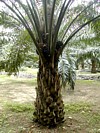|
oil palm
Common name for a palm tree of the genus Elaeis guineensis,
of which the racemes consist of large clusters of crimson seeds, that are picked and squashed to obtain palm oil,
the most widely consumed vegetable oil on the planet. The palm species
originated in West Africa and was introduced to Malaysia by the British in 1875,
and to Indonesia by the Dutch in the mid-to late 19th century, and was first
planted as an ornamental tree. Today, it is mainly cultivated in southern Thailand, on the Malay peninsula
and in Indonesia, with Malaysia and Indonesia alone making up for 85% of all
palm oil production. Palm oil is cheap and ubiquitous. It is used in cooking, as
well as in thousands of everyday products, from chocolate to instant noodles and
shampoo. Initially, the flowers were pollinated by hand, requiring a large
workforce and limiting efficiency, until in 1981 the African Palm Weevil was
introduced to pollinate the plants and palm oil yields boomed ever since, while
demand kept rising as worldwide palm oil started to replace the unhealthy trans
fats in many processed products. The global increase of ultra-processed foods
also made the demand for palm oil rise. However, the rapid expansion of palm oil
plantations has led to the destruction of huge areas of tropical rainforest.
In Thai, the tree is called
ton palm nahm man.
回






|

